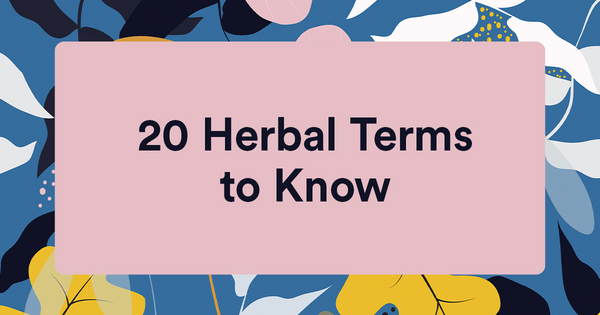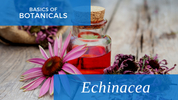20 Herbal Terms to Know

Botanicals can be highly beneficial for the human body, but navigating the vocabulary around them while researching which herbs could help you reach your wellness goals can often be confusing and overwhelming. Here are 20 of the basic terms you should know when reading up on botanicals and herbal medicine.
Adaptogen: Adaptogens are a category of non-toxic herbs that support the body’s response to occasional stress. They offer holistic support to the immune, digestive, cardiovascular, musculoskeletal, nervous, and endocrine systems. Examples include ginseng, shilajit, rhodiola, and ashwagandha.
Alkylamides: A class of fat-soluble constituents (lipids) found abundantly in echinacea and other plants like prickly ash and spilanthes, known for their ability to support a healthy immune system. They are structurally and functionally similar to endocannabinoids such as anandamide and 2-AG, and thus they are active preferentially at CB2 receptors in the endocannabinoid system.
Alterative: Literally “blood cleanser,” alteratives are a class of herbs known to support healthy circulation, as well as a healthy liver, kidneys, digestive system, and immune system. Examples include echinacea root, burdock root, and dandelion root.
Antioxidant: A substance that inhibits or removes oxidizing agents in the body and scavenges free radicals. The best sources of antioxidants are brightly-colored fruits and vegetables, along with pastured meat and eggs, wild caught fish, and cold-pressed plant oils. Learn more about antioxidants and how they work.
Ayurvedic medicine: A system of medicine originating in India more than 5,000 years ago established in the sacred Vedic texts. It aims to balance the mind, body, and spirit through herbal interventions, diet, yoga, and breathwork.
Carrier oil: An oil used to dilute, or “carry,” essential oils, cannabinoids, or other fat-soluble extracts and constituents. Common carrier oils include olive, palm, hemp, and coconut MCT.
Essential oils: Concentrated and highly volatile lipids composed mostly of terpenes derived from a plant, typically through distillation. Used for defense and survival throughout the plant kingdom, they contribute to the aroma and therapeutic properties of plants when smelled or ingested by humans.
GABA: Gamma aminobutyric acid (GABA) is an amino acid we make that functions as a neurotransmitter used to slow down or inhibit neuronal activity in the brain. This is why it is involved with a balanced mood, healthy sleep, and relaxing muscle tension. GABA is also found in our diet, especially fermented foods. Certain herbs like valerian root and hops interact with GABA receptors in the brain, contributing to their effects on sleep and mood.
Hypnotic: A botanical ingredient that helps to support sleep, typically with a much more pronounced sedative effect. Examples of hypnotics include kava kava, hops, and valerian.
Lipids: Simply defined: fats. More specifically, this is any class of organic compounds that are fatty acids or their derivatives and are insoluble in water, but soluble in organic solvents. Lipids include natural oils like EPA (an omega 3 essential fatty acid), cannabinoids like CBD, CBG, and CBN, terpenes like beta-caryophyllene and d-limonene, plus steroids like the withanolides found in ashwagandha, and waxes.
Naturopathy: A system of medicine that focuses on disease management through natural medicines and botanical extracts, dietary changes, sleep hygiene, and exercise.
Nervine: A type of herb that supports a healthy nervous system. Nervines are fantastic allies to support a healthy response to stress, as well as to relax, find calm, and wind down. Examples of nervines are hops, holy basil, skullcap, and passionflower.
Nutraceutical: The term “nutraceutical” combines “nutrient” and “pharmaceutical” to describe a food-derived product that offers health and wellness benefits in addition to nutritional value.
Nutritive: Nutritious; providing nutrition. In herbalism this refers to an herb that offers gentle, gradual support due to the presence of minerals, chlorophyll, antioxidants, and/or vitamins. Examples of nutritive herbs include milky oats, nettles, elderberry, and alfalfa.
Phytochemical: A chemical compound (or “constituent”) found in plants that plays a role in a plant’s life cycle, often contributing to the therapeutic effects in humans when consumed.
Rosavins: A group of key constituents found in Rhodiola rosea root, and is the collective name of phenylpropanoid glycosides rosavin, rosarin, and rosin. These constituents are thought to be involved with the mood-balancing and cognitive effects of rhodiola.
Tincture: A concentrated extract of one or more herbs commonly made with alcohol and water, though vinegar, ethanol, and glycerine are also widely used today. Tinctures are typically made either through maceration where the plant matter is soaked in solution for several weeks, then pressed and filtered; or through percolation where the solution is poured over the plant matter through a cone, producing a completed extract within a few days. Today, we see this term applied to hemp extract blended in oils as well when served in dropper bottles.
Traditional Chinese Medicine: This system of medicine dates back to the 3rd Century BCE and focuses on promoting the flow of the life-energy qi in the body. Traditional Chinese Medicine includes practices such as acupuncture, meditation, cupping, tai chi, and herbal therapeutics.
Western Herbalism: Drawing on the herbal traditions of Europe and North America, Western Herbalism focuses on the use of herbs as teas and extracts to support the body’s natural vitality. Within the greater umbrella of Western Herbalism, we have the Eclectic school of thought, Wise Woman Tradition, Appalachian folk herbalism, Vitalism, and more.
Withanolides: A group of plant steroids found in the nightshade family, abundant in the roots and leaves of ashwagandha. Withanolides are thought to be the main active constituent responsible for ashwagandha’s effects in the endocrine, nervous, circulatory, immune, and reproductive systems.









